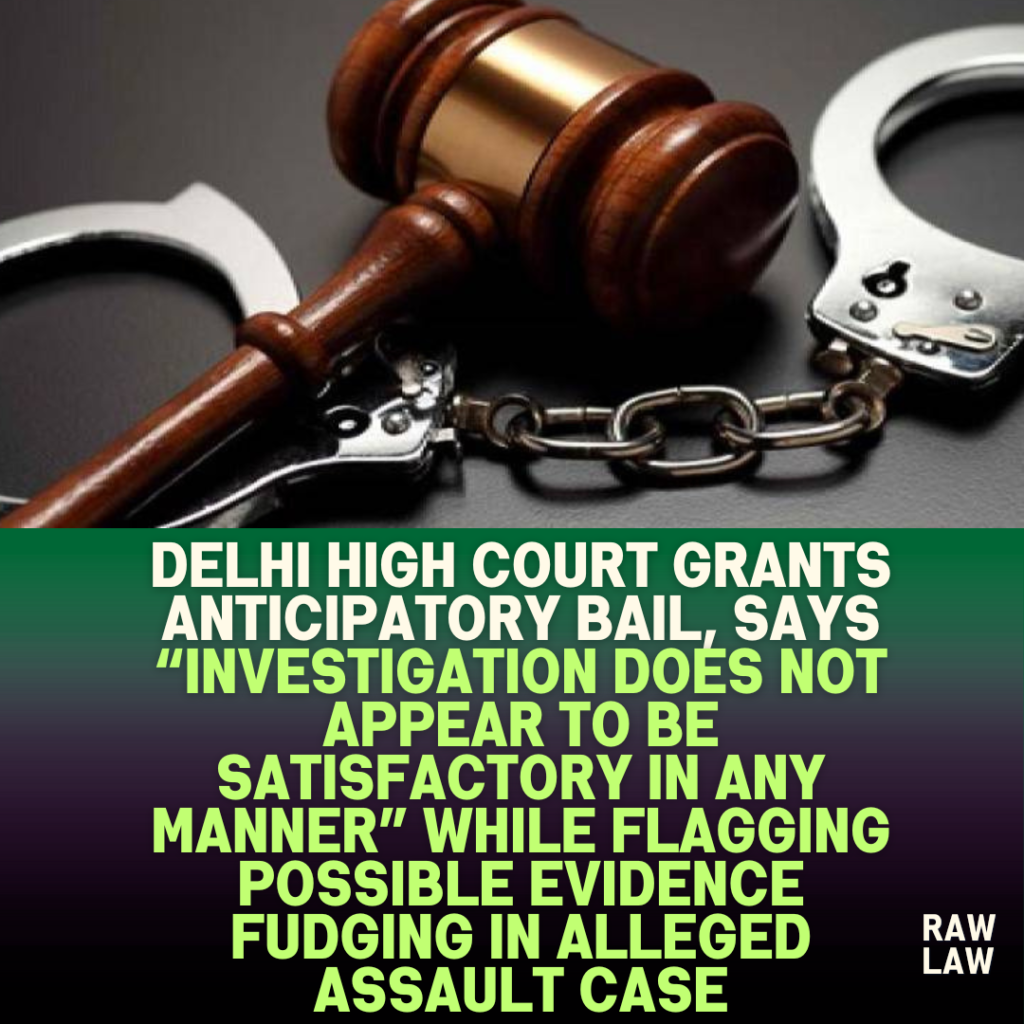Court’s Decision
The Delhi High Court granted anticipatory bail to the applicant accused of assault, noting the striking similarity in role with a co-accused who had already been granted bail. The Court observed serious lapses in the investigation, including questionable medical documentation, absence of original discharge summaries, and lack of contemporaneous X-rays to confirm alleged fractures. While allowing bail on parity, the Court directed that the matter be independently investigated to ascertain whether evidence was being manipulated.
Facts
The prosecution alleged that the applicant, along with a co-accused, assaulted the victim with an iron rod, sticks, and an iron stand, causing multiple fractures to both upper and lower limbs. The applicant sought anticipatory bail on the ground of parity with co-accused Rohit Khatri @ Jonty, who had been granted regular bail by the Court on 31.07.2025. The FIR was registered under Sections 109(1), 351(2), 118(1), 126(2), and 3(5) of the Bharatiya Nyaya Sanhita at PS Narela Industrial Area.
When bail was granted to the co-accused, the Court had noted that the Medico Legal Report (MLR) showed multiple lacerated wounds and tenderness but no X-ray had been conducted at that time. A medical opinion had described the injuries as grievous based on Hasija Hospital documents, but those documents had not been formally collected by the Investigating Officer (IO) then.
Issues
- Whether the applicant was entitled to anticipatory bail on the ground of parity with the co-accused.
- Whether the alleged fractures and grievous injuries were supported by credible, contemporaneous medical evidence.
- Whether the investigation had been conducted in a satisfactory and transparent manner.
Petitioner’s Arguments
The petitioner’s counsel contended that the applicant’s role in the alleged assault was identical to that of the co-accused who had already been granted regular bail. Since no distinguishing facts or aggravating circumstances existed, denial of bail would violate the principle of parity in criminal jurisprudence. It was argued that the investigation record did not conclusively establish the alleged fractures, making the allegations exaggerated.
Respondent’s Arguments
The prosecution opposed bail, stating that bail was granted to the co-accused only because, at that stage, the Court did not have the complete medical record. After the co-accused’s bail order, the IO had obtained documents from Hasija Hospital showing the injuries as grievous. It was submitted that this fresh material justified a different treatment for the present applicant.
However, the APP conceded that the documents collected were only photocopies of the discharge summary, with no original or radiologist report. Furthermore, the X-ray produced was dated 09.07.2025 — over a month after the alleged incident — making it uncertain whether the implants and screws shown were related to the incident or pre-existing.
Analysis of the Law
The Court relied on the principle of parity, which mandates that similarly placed co-accused should receive similar treatment in bail matters unless distinguishing factors exist. The absence of credible contemporaneous medical proof of grievous injury, coupled with missing original hospital records and unexplained delay in X-ray examination, led the Court to conclude that there was no material difference between the applicant and the co-accused’s case.
Precedent Analysis
While the judgment does not cite specific case law, the principle of parity in bail decisions is well established in precedents such as Dataram Singh v. State of Uttar Pradesh (2018) and State of Rajasthan v. Balchand (1977), where the Supreme Court held that bail should not be denied arbitrarily when co-accused in similar circumstances have been granted bail.
Court’s Reasoning
Justice Girish Kathpalia observed that:
- The investigation was unsatisfactory, lacking a case diary for collection of hospital records.
- The discharge summaries were photocopies with no originals produced.
- There was no radiologist report confirming fractures.
- The X-ray presented was taken much later, making it unreliable to prove the injuries were caused in the alleged incident.
- The discharge summary itself did not record that any X-ray was done at the time of admission.
These deficiencies raised serious doubt over the genuineness of the injury claims, warranting an independent probe into possible evidence fabrication. Given these factors, the Court saw no basis to deny the applicant the same relief as the co-accused.
Conclusion
The Court granted anticipatory bail to the applicant, directing that in the event of arrest, he be released on a personal bond of ₹10,000 with one surety of the same amount to the satisfaction of the IO/SHO concerned. The Court also ordered that a copy of the judgment be sent to the concerned DCP for necessary action regarding the investigation lapses and possible evidence tampering.
Implications
This ruling reinforces the principle of parity in bail matters and underscores the judiciary’s intolerance for shoddy investigation practices. It also sets a cautionary precedent for law enforcement that incomplete or dubious medical evidence can not only weaken prosecution cases but also attract judicial scrutiny into potential evidence fabrication.
FAQs
Q1: What is the principle of parity in bail decisions?
The principle of parity ensures that similarly placed co-accused are treated alike in bail matters unless distinguishing circumstances exist, preventing arbitrary discrimination.
Q2: Why did the Court suspect evidence fabrication in this case?
Because the hospital records were photocopies, no original discharge summaries were produced, there was no radiologist report, and the X-ray was conducted over a month after the incident, making its connection to the alleged injuries questionable.
Q3: What direction did the Court give apart from granting bail?
The Court directed the order to be sent to the concerned DCP for necessary action, signalling an independent probe into the quality of investigation and possible fudging of evidence.



